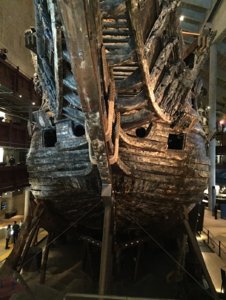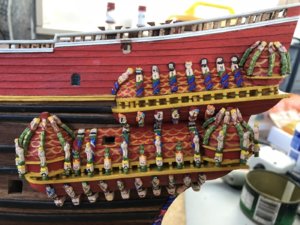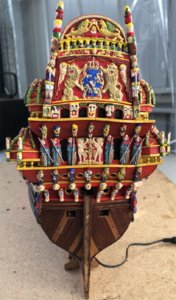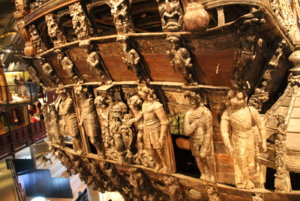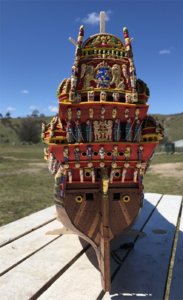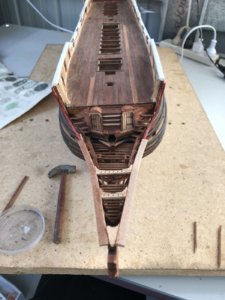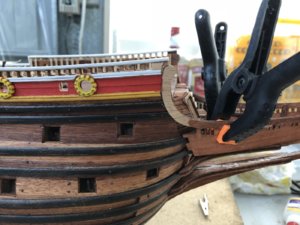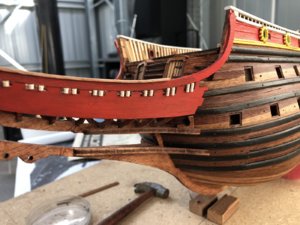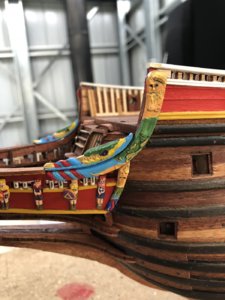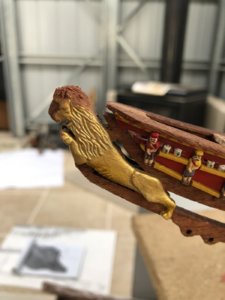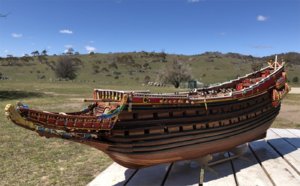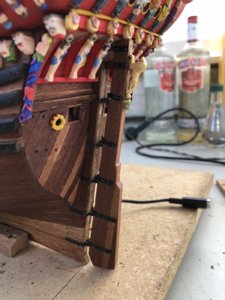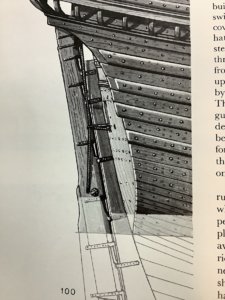The galleries and topsides are now completed to a point where I can start dealing with the artwork/sculptures and their shaping and painting. There are two stages to adding the sculptures for the Billing Boat kit-supplied figures.
Stage 1: Shaping
Billing Boats supply brown, dense plastic mouldings of the various carved figurines. These had to be shaped to conform with the various curved surfaces they needed to be fitted onto (especially in the case of the galleries). In other locations (eg bow section, the Roman figures are applied without shaping, only fitting). After a number of trials on discarded parts of the same plastic (frames), I attempted to shape the plastic. These trials included experimenting with using boiling water, hot air from a hot air gun, a ski waxing electric iron (similar to a clothes iron, but my wife wasn't happy about using that!!), a candle (as the instructions describe to use) and a curved but temperature controllable electric soldering iron. Some of these methods destroyed the plastic, melting it, others methods made it only a bit malleable so when bent to shape, the plastic cracked. The best method I found was the soldering iron on about half maximum heat. I found I could slide the back, flat surface of the figurines around the curve outer face of the soldering iron and then I had about 10-15 seconds to place it on the ship where required and bend to shape. After this time, it cooled back to being rigid and inflexible.
While the above method achieved the shaping I needed, one of the downsides (although this was an effect I noticed on ALL heating/shaping methods), was that the plastic slightly shrunk in size!! In some cases this was an advantage (when the space available on the model was tight), but generally the lengths of the figures fitted the ship for length so reducing size was an issue. The trick was to keep the heating to just enough to bend to shape, but not overheat to cause very much shrinkage. In general this worked OK, but there were a few disasters (over in excess of 200 figurines!!). Billing Boats provide only about the right number of sculptured carvings, so there was little room for error.
Stage 2: Painting
As said above, the supplied plastic was a dark brown. While the plastic took paint quite well, the brown is not a good colour when applying acrylic paints. So I needed to use a light, white undercoat to allow the best base for the overcoating. To minimise any loss of very small figure detail, I used a white spray-on undercoat while the figures were attached to their supplied frames. Below you can see an example of the plastic, supplied, unpainted figures in their frames.
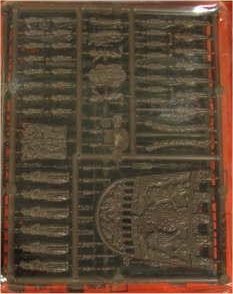
By undercoating the figures initially, this of course was pre-heating and pre-shaping. I found that the heating and bending in most cases did not cause the undercoat to come off or delaminate. In some instances there was a little cracking, but not too bad. So, with the undercoat relatively intact and the figures individually shaped, I could commence painting. My local supplier (and I live in the country, many hours from a large city), so the internet and mail postage is my normal means of supply), stocked Vallejo acrylic model paints and when trialled, these seem to give excellent, dense coverage, could be mixed effectively and dried quickly.
I purchased a range of what I thought would be the most used colours (black, white, silver, yellow, red, two blues, two greens, orange, two browns, two flesh colours and purple). Not a huge range I know, but with mixing, it should be adequate. I reviewed a lot of videos and web descriptions on acrylic model painting.
Let me tell you, there is a WHOLE NEW WORLD out there in painting of model figures. The painting is mainly targetted at gaming and painting figures for Warhammer and battles etc etc. The artwork is truly impressive with base coats, washes, highlights, dry painting and effects. If you are painting anything on your models, I urge you to spend a little time internet searching acrylic painting of plastic models/figures. It is a REAL EYE OPENER!!! some of the figures being painted is even a little risque!!
So with my newfound knowledge about techniques and a bit of experimenting I started on painting Vasa figurines. I started with small figures and got more confident (there was no shortage of the number to be done!!). I cut the figures from the frames and then painted individually. Others I know have tried painting on the frames and then cutting apart. While this is a reasonable method, the cut of course has to be then touched up later, and when mixing colours, this is not always possible, so I opted for individual figurine painting in the majority of cases. I tended to use a colour and go randomly from one figure to the next in the collection using the smae colour until done. The picture below shows this. I used a water-filled dish with baking paper sitting on wet sponge which acts as a palette and keeps the small amounts of paint useable for hours, even days, when sealed. This is a 'wet-method' idea I picked up from the internet research. You can see the water-pallette in the photo here:
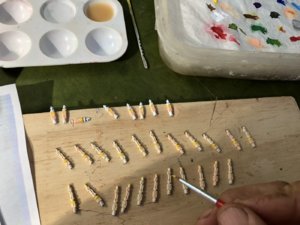
A few different paintbrushes ranging from size 00 to size 2 were used and with fresh water on hand, cleaning of the brush and moving on to different colours or different parts of each figure was not a problem. For some of the figures, spears, swords or musical instruments are seen on the original ship carvings. After painting, I added some of these for effect. I found for spears and poles etc, some trimmed brush hairs painted black or silver were ideal for the scale when CA glued on. I show some of these for the lower starboard gallery as it progresses.
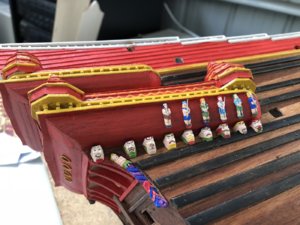
The number of figures on each side is impressive. It takes a LONG time but the effect is just amazing. In nearly all cases, I have used CA glue to attach the figures. The next photo shows the nearly completed starboard galleries.
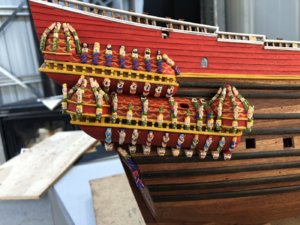
Well, nearly half way!! Now to do the portside galleries, and then the stern.
Time elapsed: 925 hours
Regards,
Peter G.
Stage 1: Shaping
Billing Boats supply brown, dense plastic mouldings of the various carved figurines. These had to be shaped to conform with the various curved surfaces they needed to be fitted onto (especially in the case of the galleries). In other locations (eg bow section, the Roman figures are applied without shaping, only fitting). After a number of trials on discarded parts of the same plastic (frames), I attempted to shape the plastic. These trials included experimenting with using boiling water, hot air from a hot air gun, a ski waxing electric iron (similar to a clothes iron, but my wife wasn't happy about using that!!), a candle (as the instructions describe to use) and a curved but temperature controllable electric soldering iron. Some of these methods destroyed the plastic, melting it, others methods made it only a bit malleable so when bent to shape, the plastic cracked. The best method I found was the soldering iron on about half maximum heat. I found I could slide the back, flat surface of the figurines around the curve outer face of the soldering iron and then I had about 10-15 seconds to place it on the ship where required and bend to shape. After this time, it cooled back to being rigid and inflexible.
While the above method achieved the shaping I needed, one of the downsides (although this was an effect I noticed on ALL heating/shaping methods), was that the plastic slightly shrunk in size!! In some cases this was an advantage (when the space available on the model was tight), but generally the lengths of the figures fitted the ship for length so reducing size was an issue. The trick was to keep the heating to just enough to bend to shape, but not overheat to cause very much shrinkage. In general this worked OK, but there were a few disasters (over in excess of 200 figurines!!). Billing Boats provide only about the right number of sculptured carvings, so there was little room for error.
Stage 2: Painting
As said above, the supplied plastic was a dark brown. While the plastic took paint quite well, the brown is not a good colour when applying acrylic paints. So I needed to use a light, white undercoat to allow the best base for the overcoating. To minimise any loss of very small figure detail, I used a white spray-on undercoat while the figures were attached to their supplied frames. Below you can see an example of the plastic, supplied, unpainted figures in their frames.

By undercoating the figures initially, this of course was pre-heating and pre-shaping. I found that the heating and bending in most cases did not cause the undercoat to come off or delaminate. In some instances there was a little cracking, but not too bad. So, with the undercoat relatively intact and the figures individually shaped, I could commence painting. My local supplier (and I live in the country, many hours from a large city), so the internet and mail postage is my normal means of supply), stocked Vallejo acrylic model paints and when trialled, these seem to give excellent, dense coverage, could be mixed effectively and dried quickly.
I purchased a range of what I thought would be the most used colours (black, white, silver, yellow, red, two blues, two greens, orange, two browns, two flesh colours and purple). Not a huge range I know, but with mixing, it should be adequate. I reviewed a lot of videos and web descriptions on acrylic model painting.
Let me tell you, there is a WHOLE NEW WORLD out there in painting of model figures. The painting is mainly targetted at gaming and painting figures for Warhammer and battles etc etc. The artwork is truly impressive with base coats, washes, highlights, dry painting and effects. If you are painting anything on your models, I urge you to spend a little time internet searching acrylic painting of plastic models/figures. It is a REAL EYE OPENER!!! some of the figures being painted is even a little risque!!
So with my newfound knowledge about techniques and a bit of experimenting I started on painting Vasa figurines. I started with small figures and got more confident (there was no shortage of the number to be done!!). I cut the figures from the frames and then painted individually. Others I know have tried painting on the frames and then cutting apart. While this is a reasonable method, the cut of course has to be then touched up later, and when mixing colours, this is not always possible, so I opted for individual figurine painting in the majority of cases. I tended to use a colour and go randomly from one figure to the next in the collection using the smae colour until done. The picture below shows this. I used a water-filled dish with baking paper sitting on wet sponge which acts as a palette and keeps the small amounts of paint useable for hours, even days, when sealed. This is a 'wet-method' idea I picked up from the internet research. You can see the water-pallette in the photo here:

A few different paintbrushes ranging from size 00 to size 2 were used and with fresh water on hand, cleaning of the brush and moving on to different colours or different parts of each figure was not a problem. For some of the figures, spears, swords or musical instruments are seen on the original ship carvings. After painting, I added some of these for effect. I found for spears and poles etc, some trimmed brush hairs painted black or silver were ideal for the scale when CA glued on. I show some of these for the lower starboard gallery as it progresses.

The number of figures on each side is impressive. It takes a LONG time but the effect is just amazing. In nearly all cases, I have used CA glue to attach the figures. The next photo shows the nearly completed starboard galleries.

Well, nearly half way!! Now to do the portside galleries, and then the stern.
Time elapsed: 925 hours
Regards,
Peter G.



